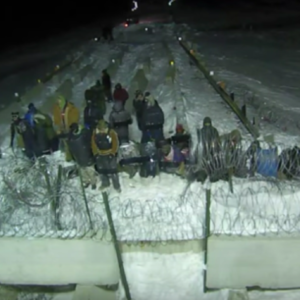Just before Christmas, officials from the Standing Rock tribe and the North Dakota Department of Transportation cooperated to inspect a bridge near the protest site. At the time, both sides hoped that this was a first step towards reconciliation and that the bridge could be reopened as soon as it passed necessary testing. Now the results are in and while the concrete is structurally sound, the bridge will remain closed because of hostile actions by protesters at the Sacred Stones camp.
“The test results show that the fire damage did not affect the structural integrity of the bridge and that it is considered structurally sound,” said a press release from the North Dakota Joint Information Center.
Nevertheless, the bridge will stay closed until local law enforcement is assured that the protesters will respect private property and law enforcement.
“Under the authority of the North Dakota governor and the Morton County Sheriff’s Department, the ND Highway 1806 roadway north of the bridge will remain closed until there is assurance no criminal activity will take place and federal law enforcement has been introduced into the protest camp to restore law and order,” the release continued.
The bridge, which crosses Cantapeta Creek, has been closed since October 27, when police pushed protesters out of a front-line camp on the pipeline route itself. The clash lasted several hours with protesters eventually setting fire to several police vehicles. Since then, the bridge has been blocked with concertina wire and concrete barricades.
In late November, protesters attempted to reopen the bridge by moving two burned cars that had been used as a makeshift barricade. Police used tear gas, rubber bullets, and fire hoses to put out fires set on the bridge and to force the protesters back. In December, the two sides reached an agreement to withdraw from the bridge in order to deescalate the situation.
Under the terms of the agreement, the police agreed to a separation between protesters and law enforcement, where police would draw back from the bridge itself and would no longer keep permanent staff on the bridge as long as protesters remained in the designated protest area south of the bridge and did not attempt to remove wire or barriers from the bridge.
“It’s not their property and it’s there for safety reasons,” said the Morton County Sheriff’s Department at a December 3, 2016 press conference.
However, this footage from a security camera left on the bridge shows that protesters have repeatedly violated the terms of the agreement by going on to the bridge to cut and remove wire. Another video, from late December shows another protester stealing a “No Trespassing” sign.
“The events of this past week [in early January] are just a few of countless instances in which protesters have violated that agreement. It seems that some in the protest camps have no interest in deescalating the situation and are only looking to provoke law enforcement into action,” said Cody Schulz, chairman of the Morton County Commission.
“Most outside of Morton County may think that because the cameras are gone and the celebrities have stopped showing up that everything has returned to normal here,” he continued, “but make no mistake, there remains a contingent of professional and violent protesters still looking to escalate the ongoing situation in our county and make the lives of our citizens that much more difficult and dangerous.”
Dave Archambault II, the chairman of the Standing Rock tribe, acknowledged that the decision to reopen the bridge would depend on the behavior of the protesters and encouraged the two sides to cooperate.
“I do hope that we can resolve everything and get it open as fast as we can,” he said.
The camp itself has not formally responded to the decision. Previously, the protesters strongly criticized the police department for closing the bridge, saying that it blocked emergency vehicles from reaching the area.

